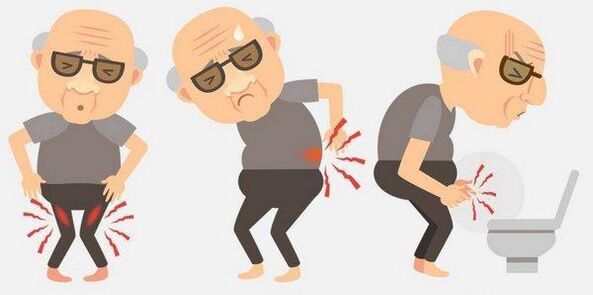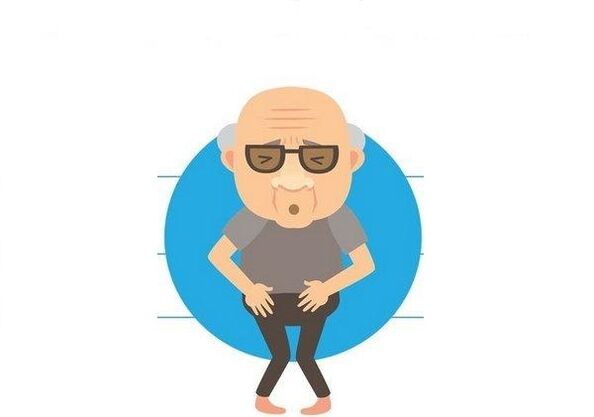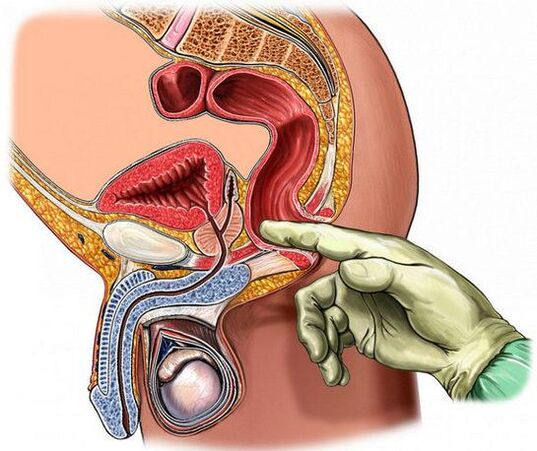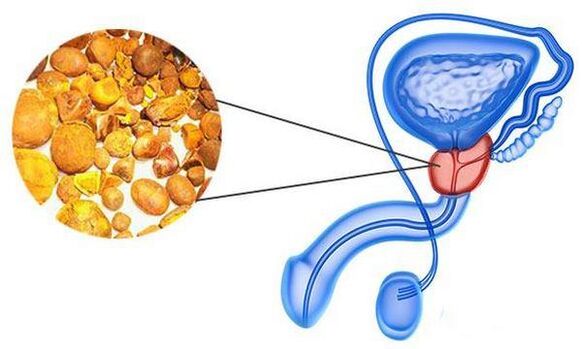Prostatitis symptoms depend on the form and causes of prostate inflammation, as well as the presence of simultaneous diseases. The symptoms often intersect, which complicates significantly diagnosis.

Chronic prostatitis
Chronic prostatitis is developing as an independent disease or as a complication of the acute form of inflammation. During the remission symptoms are weak or completely absent, with deterioration, they become more pronounced. The clinical picture reminds of acute prostatitis.
The first symptoms of chronic form of inflammation:
- Frequent urination urine;
- Dumb pain in the lower abdomen;
- Uneasiness in the prostate area (an area from the testicle to anus) with a long stay in a seated position. After that, the seating for more than an hour is not possible due to ignition;
- Dashed, painful urination;
- TUP pain in the rectum during defecation;
- It is possible to deteriorate erection, discomfort in groin during ejaculation.
The above signs in the chronic form of prostatitis do not manifest at once. Initially, it can be oiled orgasm, too early ejaculation, then a man must strain during urination, pain gradually joins.
On an ultrasound with chronic inflammation, the prostate density decrease, increased degree reflection of wave fabrics. The places decreases in the presence of cysts or appears in the places of exposure to calcined (stones), fringed focus (sealing from the connective tissue, formed due to the recovery process) after acute inflammation). In the late phases of the foci of connective tissue and fibrosis, it is more and more. The size of the prostate gland is reduced. During the visual diagnosis, it is already difficult to distinguish it from the surrounding fibers.
Acute prostatitis
Acute form of infectious (bacterial) prostatitis is characterized by rapid development. The weight of the symptom depends on the degree of damage in the gland. With the cortic form (inflammation affects only channels), man can only feel light discomfort during the stress of the inguinal region. While ironing from iron, it was slightly increased and almost painless.
Folicular inflammation of individual lobes in the gland), Parenhim (inflammatory lesion of all tissues of prostate) and abscerse (abstract capsules are formed) Forms are manifested throughout complex symptoms:

- Strong pain in groin in groin, giving rectum, testicles, sakrum, on the inside of the hips, in the penis.
- Fever, general weakness. The active development of pathogens causes the intoxication of the body with inflammatory products.
- With the relevant when urinating, the feeling of incomplete bladder discharge (due to the irritation of sphinctors and urethral mucosa).
- Gruland discharge from the urethra (gnome out of the prostate canal, opening in the urethra).
- A sense of severity in the perineum.
- Attacks of rapid heart repayment.
- CRMY urine with pure threads. Blood can appear.
With Parenhim's form of prostatitis, painful cramps and pulsating pains in the rectum make it difficult to malfunction. A little relief only happens in a pose that lies with pressure feet. Often the prostate inflammation extends to the rectum, then the mucus begins to extract from the anus. The urination with the background of the parenchymal form can completely stop due to a strong edeste gland.
External signs of acute prostatitis on ultrasound:
- Extension of venous plexes. Vascular form is more clearly expressed;
- Channel expansion and capsules gland (swelling, uneven increase, contour sting);
- Increased degree of wave rejection with fabric;
- Local bubbles on the sides of the prostate are asymmetrical due to heterogeneous charging, channels that remove seeds.
With suspicious neoplasms, MRI or CT prescribes.
Stance prostatitis
Prostatitis stagnation (also called bacterial in the absence of infections) can develop in men younger and older. The main symptoms are similar to an inferior chronic inflammation. The distinctive characteristic is that discomfort from the urinary system manifests and boosts mainly due to long-term sexual abstinence. The deterioration may cause a violent expansion of sexual intercourse, non -core orgasm (sex without proper emotional color). Far, painful urination (wandering) is usually observed in the morning. However, if the day before was a full orgasm, there are no cramps.
With this species, prostatitis is the amount of leukocytes in the secret gland does not exceed the norm, there is no pathogenic flora in the third part of the urine.
Calcutal prostatitis
Calcutal prostatitis has no specific symptoms. The presence of stones (calcinates) in the gland does not mean automatically development of your inflammation. With physical effort, background pain can be intensified. Migration of stones through channels sometimes causes the occurrence of blood in urine.
During the prostate ultrasound were discounted calcined. Due to the increased density, they effectively reflect waves that emit the device.
Features of prostatitis manifestation in a young and mature age

The symptoms of different forms of prostatitis do not depend on the man's age category. Young people are actively living sex life, and more often develop an acute form of contagious inflammation with appropriate pronounced characters.
Chronic prostatitis is diagnosed in men for several years after the beginning of sexual activity. During this time, due to the activities of hidden infections, the prostate structure has been violated, its cell immunity was reduced. Symptoms appear at the time when pathological changes are already irreversible.
Mature men generally suffer from urination disorders, periodic stupid pain in perineum and erection disorders. The licking prostatitis in this age is worsened by stall processes in the pelvis on the background of androgenic failure and muscle loss.
When and to whom to address
Any of the above symptoms is the reason for contacting urologists or in Androlog (diagnosis of prostatitis in clinical and home conditions). Many men avoid going to the doctor due to a negative attitude to examine a prostate finger through anus or Trusie. If the patient categorically rejects these types of studies, the doctor will offer a transabdominal ultrasound - when the sensor leans on the lower abdomen. The uracon should be filled (just drink 350 ml of fluids for an hour before the procedure).
Based on the results of ultrasound, the doctor determines the nature of the prostate tissue lesion that surrounds its tissues and bubbles. To identify the cause of inflammation, it is necessary to pass urine, blood, prostatic secret (you need a rectal gland massage), in some cases and spermogram.
What diseases do similar symptoms have
Many diseases have symptoms similar to spending. First of all, it's CISTITIS (inflammation of the bladder). It is characterized by a frequent toilet, spoiling in the lower abdomen, pain during urination, muddy urine, sometimes with blood. Maybe a slight increase in temperature.
In men older than 45, with prostatitis symptoms, gland and gland cancer are primarily excluded. Inflammation against the background of these pathology is often a secondary sign. Symptoms of cancer glands are similar to the manifestations of chronic form of prostatitis: periodic urination disorders that drag pain. The prostate is painless with a finger studio, but thick nodes are located in their structure.
Far night urination, slow flow of urine, a sense of incomplete emptying of bubbles, leaking drops from urethra and weight in the perinium is characteristic of Aden. The picture clarified the palpation and ultrasound: the contours of prostate are preserved, consistency is elastic, the surface is smooth, iron is almost painless.
Urinary and abbreviation pain disorders can occur with non-infected prostate stones - are present - calcinates, but there is no favorable environment for combining pathogens around them. Uneasiness in the perineum in this case causes physical activity, ejaculation. With a sense of prostate under the fingers, criticism (stones) can be felt, the body gland is thick, tuberna, moderately painful.
Disorders in urination, characteristic of the chronic phase of the disease, are also characteristic of the sclerosis of the bladder sphincter (obstacle barrier in the shape of a protrusion for cutting). Pathology is often the result of an extended prostate. In men under the age of 40, rarely is diagnosed.
Extended venous nodes (internal hemorrhoids) are often taken for chronic prostatitis. Can only be found using a special diagnostic tool. Symptoms:
- Pain in anus, giving cross and crotch;
- Erection injuries;
- Strengthening the pain in the rectum and perineum during the defecation or extended invention in a seated position.
The contours and consistency of prostate are unchanged. In their secrecy pathological change are absent.

The pain in the area of the anus and perineum occurs with proxy - inflammation of the rectum. The characteristic characteristic is strong burns sensation in the anus during and after defecation, giving penis and crotch. There is an urge for frequent urination (every 20-30 minutes), followed in Lacus urine. Protatit often develops simultaneously with prostatitis. In this case, parallel therapy is needed for both diseases.
Prostatitis symptoms are also manifested with tuberculosis glands. In the risk zone of a man from 20 to 40 years. At the initial phases of development, the disease is almost asymptomatic. There are occasional lower pain in the rectum and perinjum. Voting violations begin with the background of inclusion in the pathological process of parts of the gland, the communicating channel that emit urine.
With tuberculosis, the praulent cavity in the prostate body. When they break through, the content flows into the urethra and is released from the penis during defecation. The bacteria that fell into the ureter irritating the mucous membrane, provokes fast and painful urination. Through fiber, PU can be expanded to the rectum. In this case, there is an increase in temperature, weakness, sweating, weight loss.
Conclusion
The prostatural gland through the nerve plexus is closely related to other pelvic authorities, whose inflammation gives symptoms similar to prostatitis. The doctor must distinguish (distinguish) prostatitis from other diseases and identify related. The patient should not surprise the fact that with symptoms of prostatitis is aimed at not only iron, but also on other organs, especially in the rectum. It is important to exclude their participation in the formation of pain and urination disorders, otherwise treatment will be inefficient.























